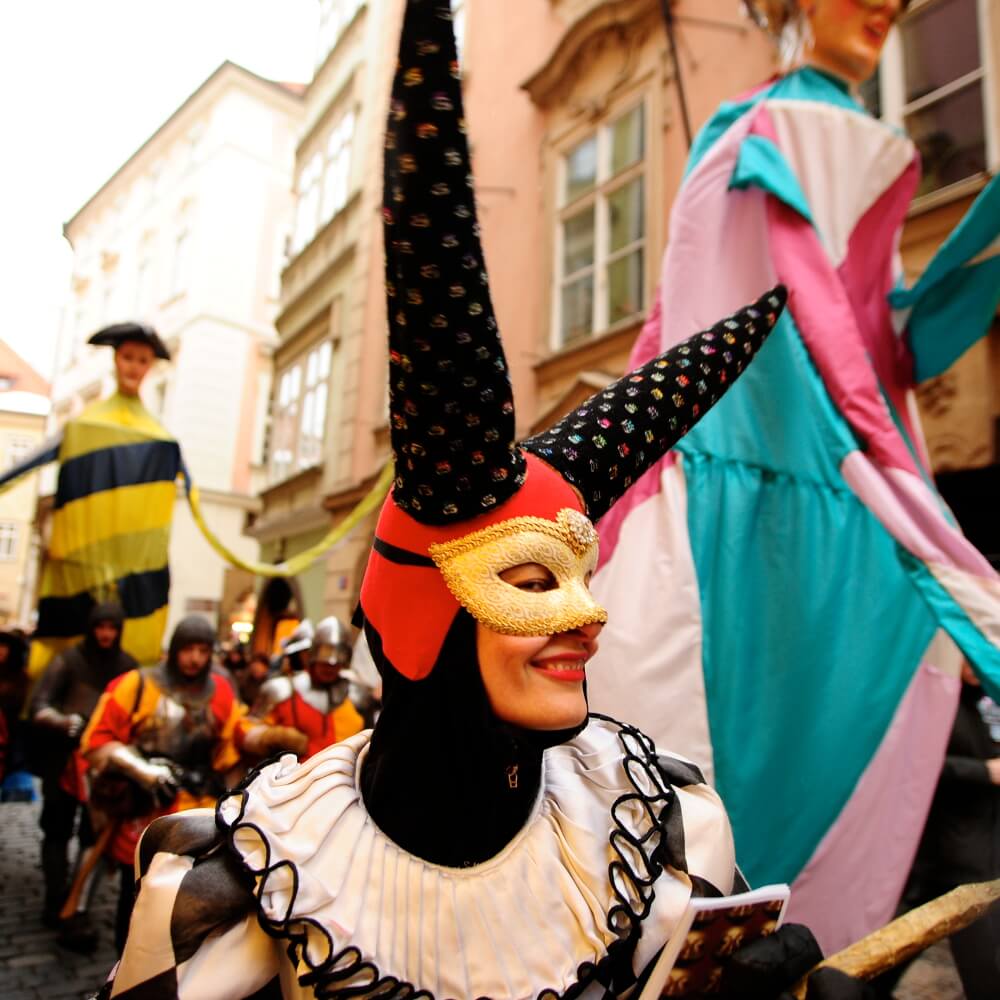Food
Holy Krapfen: Carnival Specialties Around The World
Slide Nr 1For hundreds of years in countries with a long Catholic history, Carnival festivities have been a chance to eat, drink and make merry – before giving up worldly pleasures for the 40 days of austerity known as Lent. To prevent waste and temptation, people would eat their fill of foods rich in meat, eggs, butter, sugar and other ingredients forbidden during Lent fasting, and as they did, they were unknowingly giving rise to local food traditions that would endure for centuries. We ask foodies around the world to share the indulgent treats enjoyed in their region at Carnival time.
0/14
Food
Holy Krapfen: Carnival Specialties Around The World.
Slide Nr 2Rome, Italy – “If you’re visiting Rome in the brief period in between the Christmas and Easter holidays, a trip to the bakery should be at the top of your list. During Carnevale, which this year is from 27 January through 13 February, you’ll find the deep-fried sweet treats called frappe and castagnole. Frappe are strips of flaky pastry dough dusted with powdered sugar, and castagnole are a kind of doughnut hole rolled in sugar and sometimes filled with sweetened ricotta. You have to be quick, though, because once Lent begins, these special winter indulgences disappear.” – Gillian Longworth McGuire of gillianslists.com [Photo: FilBenLeafBoy/Wikimedia Commons]
1/14
Food
Holy Krapfen: Carnival Specialties Around The World.
Slide Nr 3Brazil – “In Brazil, Carnival, a feast with European origins, celebrates spring, abundance and fertility. Brought to Brazil by the colonists, the feast has become a part of the national identity, blending with the traditional celebrations of native cultures and the African peoples brought as slaves. During Carnival, music and dance takes over every where – and the energy required to dance for three days is typically replenished by rich dishes based on beef, pork and legumes – such as feijoada and sarapatel in Bahia, Pernambuco, São Paulo and Rio de Janeiro; and barreado in Paraná. Caipirinha and batida, drinks made with cachaça and fruit, are always present, as are sweets like the memorable filhoses.” – Flora Refosco of florarefosco.com
2/14
Food
Holy Krapfen: Carnival Specialties Around The World.
Slide Nr 4Barranquilla, Colombia – “A meeting of cultural, folkloric and dance expressions, the Carnival of Barranquilla is one of the most important festivals in Colombia. And although the Carnival is synonymous with rumba and joy, gastronomy often takes centre stage, with a great variety of typical delicacies from Barranquilla and the Colombian coast. One of the most popular is arepa e’ huevo (egg arepa), a type of corn-based bread with egg inside. Its preparation consists of frying the dough beforehand, then pouring in a raw egg and frying it again.” – Jenny Aguirre, Amex Essentials Spanish Editor [Photo: patrickheagney/Getty Images]
3/14
Food
Holy Krapfen: Carnival Specialties Around The World.
Slide Nr 5Malta – “Carnival in Malta spans as far back as the 15th century, before the Knights of St John arrived, with a wonderful street parade taking place in the capital, Valletta, every year around mid-February. Here, Carnival means many things, but to most, prinjolata, our traditional Carnival cake, is the first thing that comes to mind. Prinjolata comes from the word prinjol (Maltese for pine nuts), so it’s no surprise that it’s made with pine nuts, as well as candied cherries, citrus peel and sponge cake, and then lavishly decorated. My recipe for a modern version of this classic can be found here.” – Marlene Zammit of amaltesemouthful.com [Photo: Mbriffa/Wikimedia Commons]
4/14
Food
Holy Krapfen: Carnival Specialties Around The World.
Slide Nr 6New Orleans, USA – “For many, New Orleans is synonymous with Mardi Gras, and for locals, Mardi Gras means it’s time for King Cake! The tradition of King Cake to celebrate the Epiphany began 300 years ago as a French bread-like pastry topped with sugar, and the New Orleans version has evolved over the centuries to a sweet brioche dough that can be stuffed with any number of fillings, from classics like cream cheese and praline, to more modern twists like maple bacon or even savouries like boudin! Inside the King Cake is a hidden token, usually a small plastic baby, and the person who finds it in their slice is responsible for purchasing the next cake. This icon begins its reign as the king of eats on Twelfth Night (the beginning of the Mardi Gras season on January 6) and is available throughout the region through Fat Tuesday. Each bakery puts their own twist on their specific King Cakes, creating passionate, loyal followings among locals: Ask New Orleanians where to find the best King Cake, and they’ll be eager to tell you about their favourite!” – Jessica and Trey of amournola.com [Photo: bhofack2/Getty Images]
5/14
Food
Holy Krapfen: Carnival Specialties Around The World.
Slide Nr 7Munich, Germany – “ In Munich, Krapfen (jelly doughnut) is a fluffy pastry, usually filled with jam and sprinkled with powdered sugar, that’s closely associated with Carnival. Due to their fat-laden recipe, these pastries have been eaten before the deprivations of Lent since medieval times. Traditionally baked with butter, eggs and milk, Krapfen – which has different names in different regions of Germany – can be veganised with the help of soy milk and margarine. They come with a variety of different fillings, but for me, the warm fluffiness and seductive taste of rosehip jam makes it an irresistible treat. Hungry for an oven-fresh pastry now?” – Ricarda Holweg, hiddentraces.com
6/14
Food
Holy Krapfen: Carnival Specialties Around The World.
Slide Nr 8Cádiz, Spain – “Pestiños are sweet, crunchy little morsels of dough, flavoured with sesame and anise, fried and then drenched in honey syrup or dusted with cinnamon sugar. They’re made throughout Andalucía, but are a cherished part of the pre-Lent celebration that is Cádiz Carnival, where thousands are enjoyed by the revellers who pack the streets of this ancient and atmospheric city.” – Annie Manson of Annie B’s Spanish Kitchen [Photo: nito100/Getty Images]
7/14
Food
Holy Krapfen: Carnival Specialties Around The World.
Slide Nr 9Goa, India – “Goa is the only place in India where one can experience Carnival festivities. Back in the 18th century, the Portuguese who ruled Goa for over 500 years started the tradition, and today the streets come alive with colour and music at Carnival time. Food is a very important aspect of the celebrations, because it’s the last opportunity [for religious adherents] to indulge in meat before Lent begins. Moreover, the food of Goa is truly special, as it’s a unique blend of Indian and Portuguese flavours. The locals enjoy dishes like sorpotel (a very spicy pork dish), feijoada (Portuguese beef stew with a Goan touch), chouriço (spicy pork sausage), beef croquettes and roast beef.” – Sonal & Sandro Paladini of drifterplanet.com [Photo: Manu_Bahuguna/Getty Images]
8/14
Food
Holy Krapfen: Carnival Specialties Around The World.
Slide Nr 10Oruro, Bolivia – “The Carnival of Oruro, a UNESCO Intangible Cultural Heritage of Humanity, is the most important festival in the country. Across three days of celebration and dance, we eat puchero, a dish with lamb meat, beef and pork, accompanied by chickpeas, corn, potatoes, sweet potatoes, white rice, cabbage, chuño (dried potatoes) and red chili sauce. A hearty dish with plenty of protein, carbohydrates and a spicy touch of red chili pepper that gives it a burst of flavour. The perfect dish to continue the revelry with a lot of energy.” – Yolanda Aguilera of thefoodiebloggers.com [Photo: Koppchen/Wikimedia Commons]
9/14
Food
Holy Krapfen: Carnival Specialties Around The World.
Slide Nr 11Québec City, Canada – “Caribou is an essential part of Québec City’s Winter Carnival experience. Made from a mix of red wine, spices and alcohol, Caribou resembles the German Glühwein, only stronger in alcohol content. Served hot, preferably consumed while watching one of the two night parades, Caribou is traditionally sipped from a long, hollow red cane decorated with the head of Québec City’s Winter Carnival mascot, Bonhomme Carnaval. Santé!” – Allison Van Rassel of foodiequebec.com
10/14
Food
Holy Krapfen: Carnival Specialties Around The World.
Slide Nr 12Limburg, Netherlands – “Carnaval in Limburg is a colourful five-day-long revelry of music, dancing, laughter and drinking. All that physical energy has to be maintained – and in the southeastern part of the province, nonnevotten provide the fuel. These pillowy knots of deep-fried dough (called “nuns’ bums” after the bow on the back of Franciscan sisters’ aprons) are rolled in sugar before being served, and are best eaten warm and fresh, straight from the baker’s oven. The combination of grease, sugar and warmth provides enough energy to keep going, especially when it’s cold outside.” – Nicole Holten of thedutchtable.com [Photo courtesy Nicole Holten]
11/14
Food
Holy Krapfen: Carnival Specialties Around The World.
Slide Nr 13Montevideo, Uruguay – “Uruguayan Carnival is unique in its duration and character: It’s the longest in the world, spanning 35 days, and it mixes a series of unequalled ethnic traditions, like candombe dancing brought by African slaves, and murga musical theatre brought by the Spanish. Although there’s no one dish emblematic of this time of year, street foods are very important, especially during the 18 de Julio Avenue parade. You can see many stands selling tortas fritas, fried bread discs made with pork fat, which are great for washing down all the drink that goes along with the celebrations.” – Steffi Rauhut of notonlysaladblog.com [Photo: Carlos Alberto Kunichek/Getty Images]
12/14
Food
Holy Krapfen: Carnival Specialties Around The World.
Slide Nr 14Veracruz, México – “During the Carnival of Veracruz, the jarochos (as the residents call themselves) prefer typical local snacks that are quick and easy to prepare – allowing them to continue partying. Among the main ones are shrimp empanadas; fried fish accompanied with lemon and hot sauce; picadas, delicious pieces of tortilla eaten with sauce, cream and cheese; and of course, Volován Jarocho, a puff pastry stuffed with pineapple or chicken. If you prefer a main course, the recommended one is Huachinango a la Veracruzana, a baked fish served with a tasty sauce of onion, garlic, tomato, jalapeños, olives and herbs.” – Laura Micaham of soylacomensal.com [Photo: Arlette Lopez/Getty Images]
13/14
Food
Holy Krapfen: Carnival Specialties Around The World.
Slide Nr 15Greece – “Tsiknopempti is the most celebrated culinary tradition of the Carnival season in Greece. Literally meaning “Smoked Thursday”, this is a feast day when great amounts of meat are consumed, mostly grilled over charcoal. Then, the following week, the first Monday of Lent is Kathara Deftera (Clean Monday) featuring a traditional meal, usually set outdoors with family and friends. On this day, Greeks enjoy much lighter foods like lagana bread, seafood, bean stew, olives, pickles and of course taramosalata, a popular dip made with cod roe, bread, EVOO, onion and lemon juice. The meal always ends with tahini-based halva for dessert, and then flying kites with the children.” – Mirella Kaloglou and Panos Diotis of littlecookingtips.com [Photo courtesy littlecookingtips.com]
14/14















Sorry, the comment form is closed at this time.